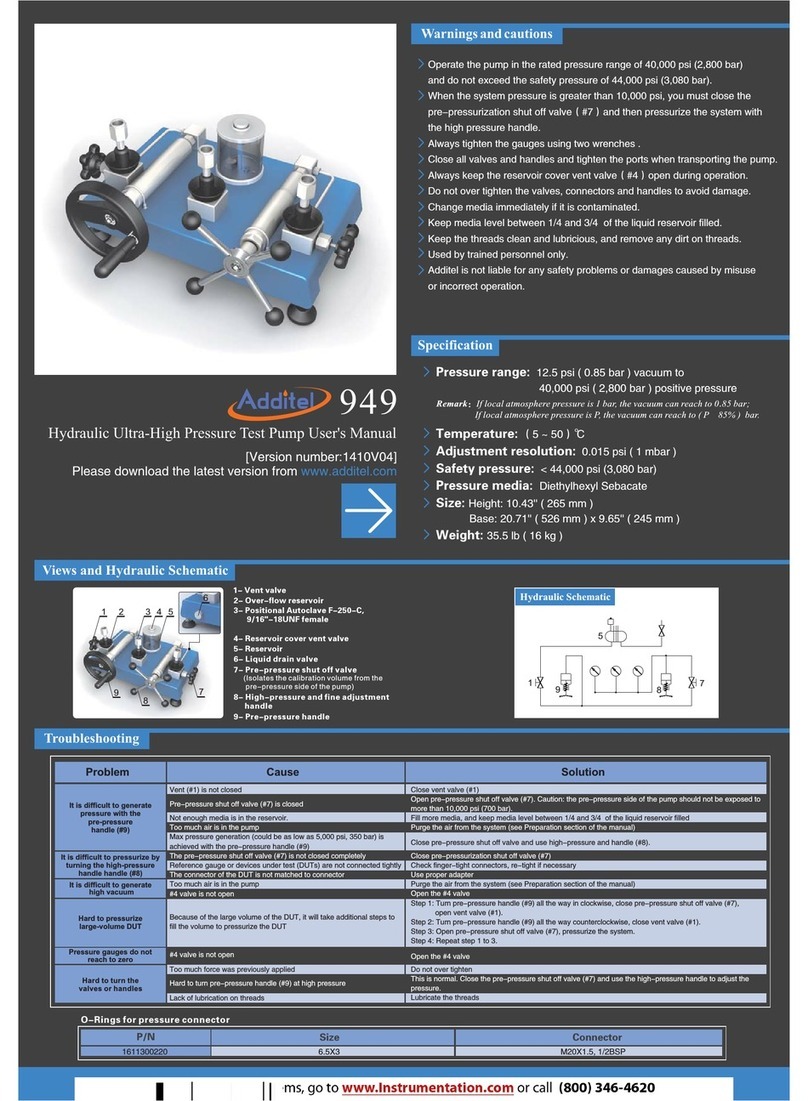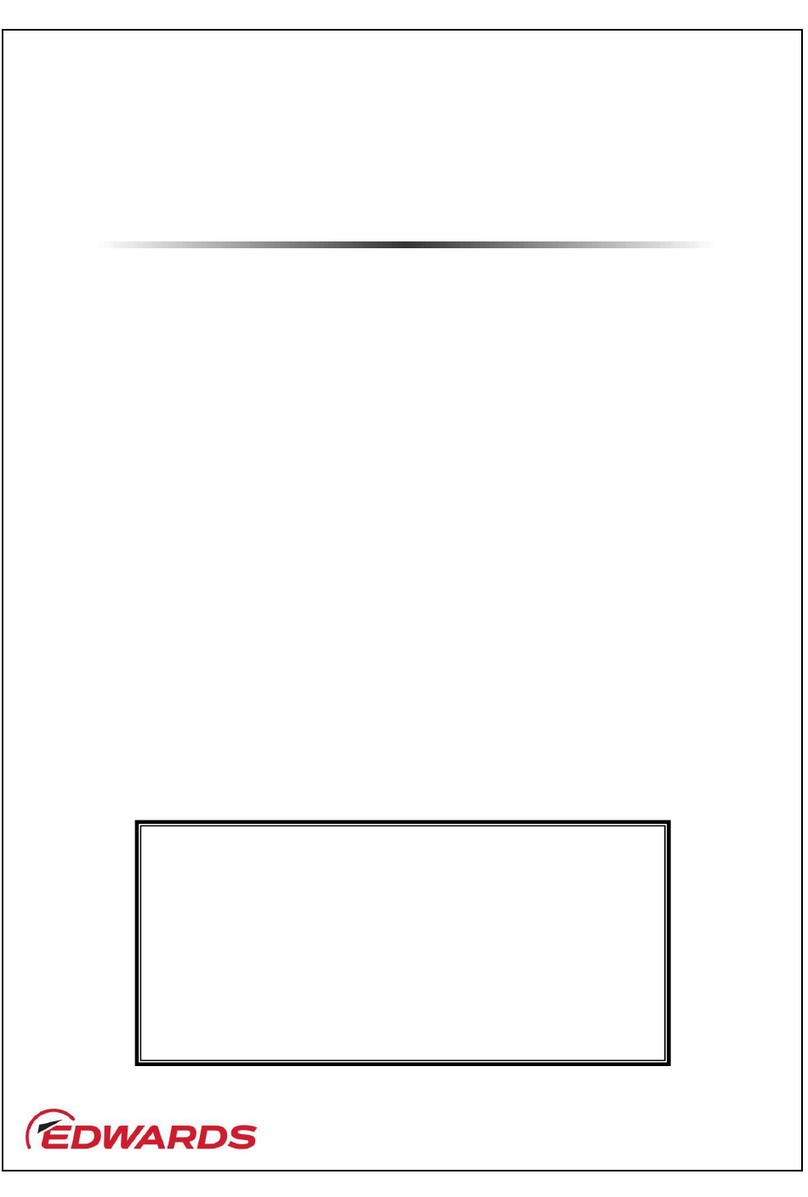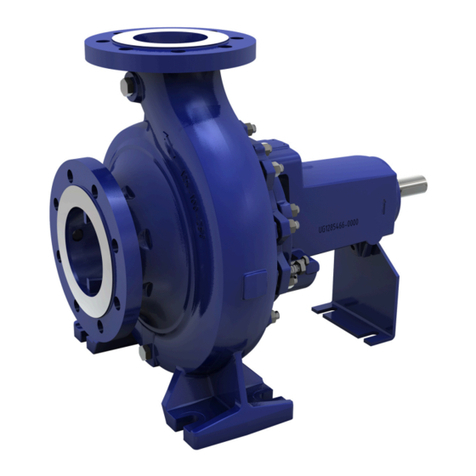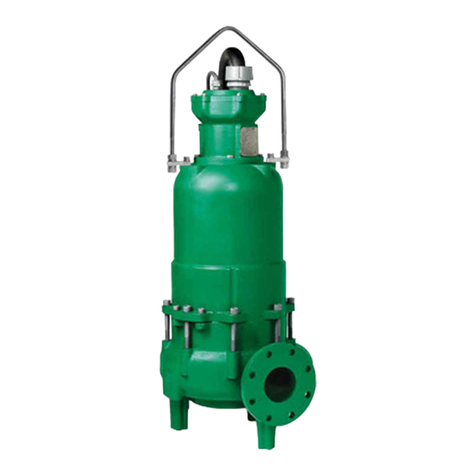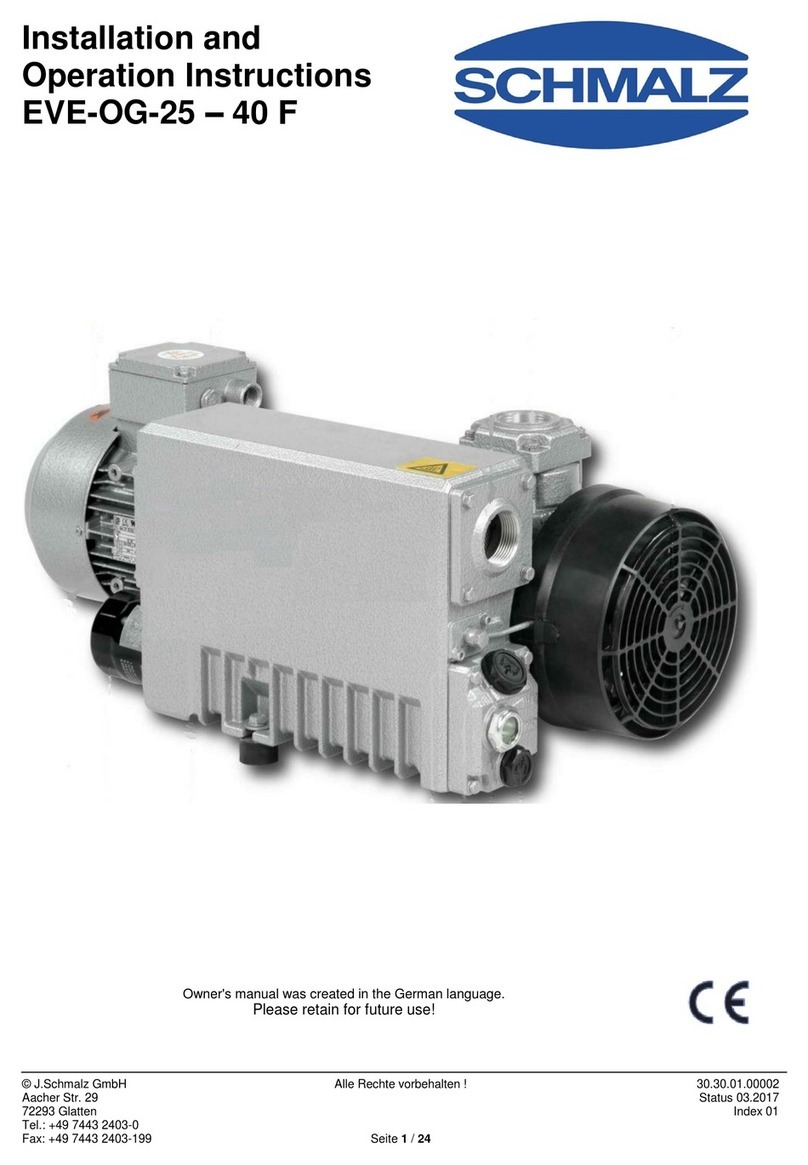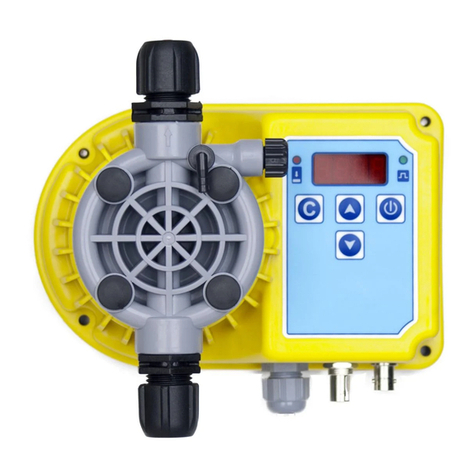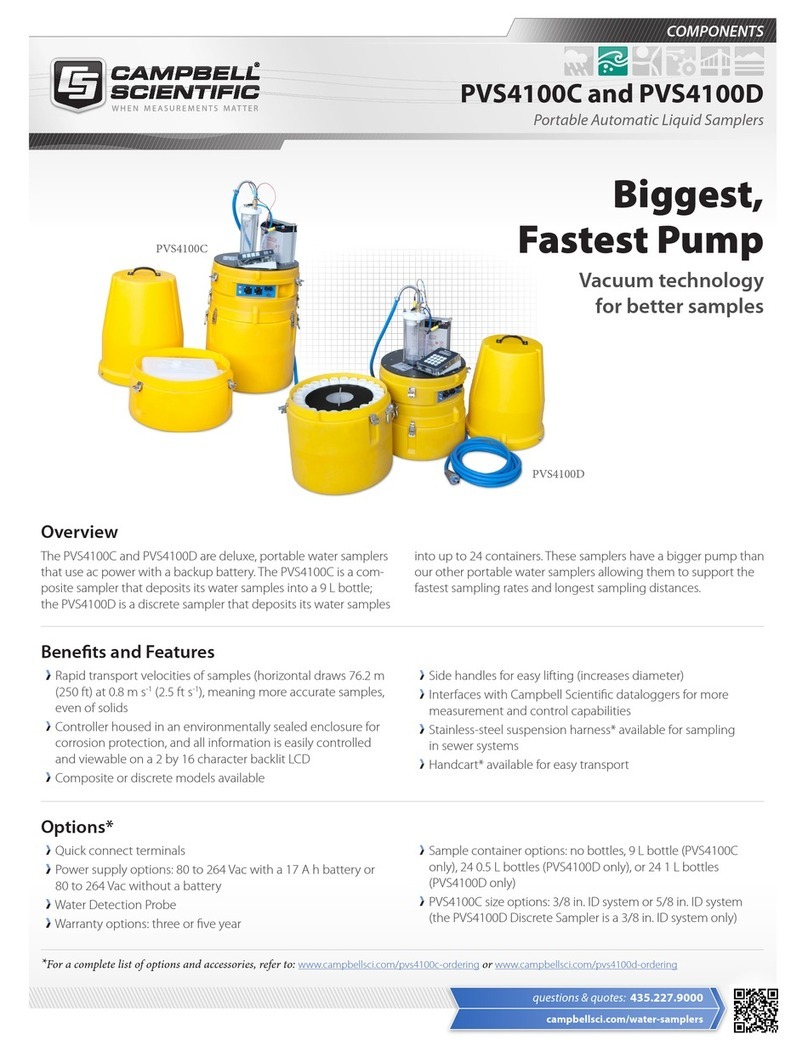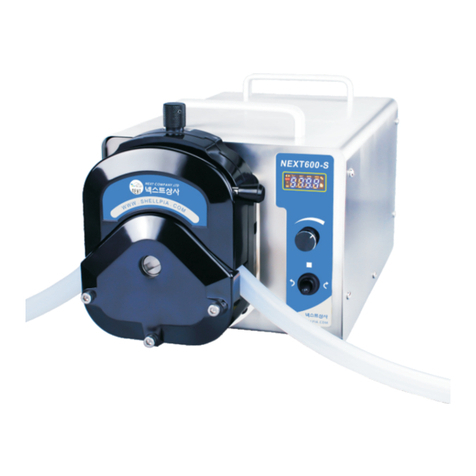Seepex BW 10 Manual

sc
Operating and Maintenance
Instructions
Progressive Cavity Pump
range size
BW 10
commission-No.
822812
Job # 2109552
This operating and maintenance instruction
includes important safety information and
instructions for installation, commissioning,
operation and maintenance of the seepex machinery.
It is essential therefore, that the responsible
specialist refers to it before starting any
work on the machinery as well as prior to
commissioning. Furthermore, this instruction
must always be available on site.

General
Ausgabe
issue A / 10.12.1994 Dokument
document OM.GEN.01e Blatt
sheet 1(2)
1.0
General
1.1
Application
These operating instructions contain basic infor-
mation on the installation, commissioning and
maintenance of seepex machines. Compliance with
the work steps described in the individual sections is
essential.
1.2
Details of the seepex machines
1.2.1
Operating Instructions
The Commission Number (comm. no) assigns the
operating instructions to a particular seepex
machine. The operating instructions are produced in
relation to a specific job/commission and are valid
only for the machine whose comm. no. is identical
with that indicated on the cover sheet and
possessing the associated data sheet, Point 9.
1.2.2
Manufacturer
The machines were manufactured by seepex.
1.2.3
Range, Size, Version
of the machines are stated in the appended data
sheet, Point 9.
1.2.4
Machine Comm. No. and Year of Construction
are stated on the type plate at the machine.
1.2.5
Release Date of the Operating Instructions
is stated on the cover sheet of the operating
instructions.
1.2.6
Modifications, Notes of Modification
If modifications to the machines are
carried out in agreement with seepex, a new set
of operating instructions will be provided, or the
existing operating instructions will be supplemented by
an additional sheet together with a new cover sheet.
The date of modification and modification index will be
noted on the new cover sheet.
1.2.7
EEC Machine Directive
1.2.7.1
Manufacturer's Declaration
seepex Manufacturer's Declaration as required by the
EEC Machine Directive 89/392/EEC, Appendix II B:
The seepex machines delivered in accordance with
our design are intended to be fitted in one machine or
assembled together with other machines to form one
machine/plant. The commissioning of the machine is
forbidden until such a time as has been established
that the entire machine/plant satisfies the
requirements of the EEC Directive for Machines as
amended 91/368/EEC and 93/44/EEC.
Particular attention must be paid to the safety
requirements specified in EN809 (s and Equipment
for Fluids) as well as the information in these
operating instructions.
1.2.7.2
Declaration of Conformity
seepex machines possessing no safety accessories
do not fulfill the requirements of the EEC Machine
Directive 89/392/EEC as amended 91/368/EEC and
93/44/EEC.
For this reason, no Declaration of Conformity as
required by the EEC Machine Directive 89/392/EEC,
Appendix IIA can be issued before appropriate safety
devices have been installed/mounted on the machine
and/or plant with due regard to the information given
in these operating instructions.
The following harmonized standards are particularly
applicable:
EN 809, EN292T1, EN292T2
Applicable national standards and specifications must
be taken into consideration.
Following assessment of the conformity of the
machine/plant with the EEC Machine Directive,
customers may on their own initiative place on the
full machine/plant the EEC symbol 'CE' as defined in
Identification Directive 93/68/EEC.
CAUTION
This documentation must be kept available for at
least 10 years.
4

General
Ausgabe
issue A / 10.12.1994 Dokument
document OM.GEN.01e Blatt
sheet 2(2)
1.2.8
Copyright and Industrial Property Rights
These operating instructions are copyrighted. The
reproduction, in particular by photocopying, of these
instructions is not permitted (§§ 54, 54 UrhG) and
constitutes a criminal offence (§ 106 UrhG).
Proceedings will be instituted if the copyright is
violated.
1.2.9
Specifications Required for Inquiries and Orders
The following information must be included when
inquiring about replacement parts or placing orders:
-comm. no.
- / machine type
This information is given on the type plate mounted
the machine.
1.2.10
Technical Data Sheet
see Point 9.
1.2.11
Performance Data, Load Index, Power
Consumption
are indicated in the associated data sheet, Point 9.
1.2.12
Sound Pressure Level
The sound pressure level and/or noise characteris-tics
of the seepex machines are ascertained in
accordance with DIN 45635. The measuring
guidelines are largely identical with the international
standards ISO 3740-1980 and ISO 3744-1981.
1.2.13
Operating Range
Employment of the machine is not permissible for
purposes other than those stated in the data sheet,
see Point 9. seepex cannot accept liability for damage
arising through failure to comply with this operating
range.
1.3
Supplementary Information
1.3.1
Accessories, Optional Extras
Please refer to the data sheet, Point 9.
1.3.2
Company Address, Service Addresses
see Point 11
5

Safety
Ausgabe
issue B / 21.04.1999 Dokument
document OM.SAF.01e Blatt
sheet 1(2)
2.0
Safety
These operating instructions contain basic require-
ments to be observed during the installation, opera-
tion and maintenance of the machine. Therefore, the
instructions must be read by the mechanical fitter and
by the technical personnel/operator responsible for
the machine prior to assembly and commissioning,
and kept available at the operating site of the
machine/plant at all times.
Compliance is required not only with the general
safety instructions given in this section but also with
the detailed instructions, e.g. for private usage, given
under the other main headings in these operating
instructions.
2.1
Labeling of Advice in the Operating Instructions
In these operating instructions safety advice whose
non-observance could lead to danger for life or limb is
labeled with the following general hazard symbol:
safety symbol acc. to ISO 3864 - B.3.1
Warnings regarding electric power are labeled with:
safety symbol acc. to ISO 3864 - B.3.6
Safety instructions whose non-observance could
jeopardize the machine and its functions are labeled
by the word
CAUTION
Always comply with instructions mounted directly on
the machine, e.g.
- rotational direction arrow
- fluid connection indicators
and ensure that the information remains legible.
2.2
Personnel Qualifications and Training
Personnel charged with operation, maintenance,
inspection and assembly must be in possession
of the appropriate qualifications for the tasks.
The company operating the machine must define
exact areas of responsibility, accountabilities and
personnel supervision schemes. Personnel lacking
the required skills and knowledge must receive
training and instruction. If necessary, the opera-ting
company may commission the manufacturer/
supplier to conduct these training courses. Further-
more, the operating company must ensure that the
personnel fully understand the contents of the
operating instructions.
2.3
Dangers Resulting from Failure to Observe
Safety Instructions
Failure to comply with the safety instructions may
lead to hazards to life and limb as well as dangers
for the environment and the machine. Non-obser-
vance of safety instructions can invalidate the right of
claim to damages.
The following are just some examples of possible
dangers resulting from failure to comply with the
safety instructions:
- Failure of important machine/plant functions
-Failure of prescribed methods of service and
maintenance
- Danger to life and limb due to electrical,
mechanical and chemical influences
- Danger to the environment due to the leakage
of hazardous substances
2.4
Safety-conscious Working
Always comply with the safety instructions listed in
this document, the existing national accident
prevention regulations and any company-internal
work, operating and safety rules.
6

Safety
Ausgabe
issue B / 21.04.1999 Dokument
document OM.SAF.01e Blatt
sheet 2(2)
2.5
Safety Instructions for the Operating
Company/Machine Operator
- Any potentially hazardous hot or cold machine
parts must be provided with protection against
accidental contact at the customer´s premises.
-Protective guards for moving parts (e.g. coupling)
must never be removed while the machine is in
operation.
- Leakages (e.g. in the shaft seal) of hazardous
conveying liquids (e.g. explosive, toxic, hot) must
be drained in such a way that no danger arises for
persons or for the environment. Always observe
the relevant statutory requirements.
- The risk of exposure to electrical power must be
eliminated (for details, see the VDE regulations, for
example, or those of the local power supply
company).
2.6
Safety Instructions for Maintenance, Inspection
and Assembly Work
The operator must ensure that all maintenance,
inspection and assembly tasks are carried out by
authorized and qualified personnel who have studied
the operating instructions closely and become
sufficiently familiar with the machine.
As a basic rule, the machine must be brought to
astandstill before work is carried out. Always comply
with the de-commissioning procedure described in
this document.
Any machines or assemblies conveying media that
are detrimental to health must be decontaminated.
Immediately following completion of work, all safety
and protective devices must be replaced
in position and, where applicable, re-activated.
Before re-starting the machine, observe the points
listed under the heading "Initial Startup".
2.7
Unauthorized Modification and Manufacture of
Replacement Parts
Conversions or modifications of the machine are
permissible only in consultation with the manu-
facturers. Original manufacturer replacement parts
and manufacturer-approved accessories enhance
the operational safety of the machine. The usage of
unauthorized parts may lead to the nullification of the
manufacturer's liability for any resultant damages.
2.8
Impermissible Modes of Operation
The operational safety of the machines supplied is
warranted only for employment in accordance with
the intended use as defined in Section 1 - General -
of these operating instructions. Never allow the
threshold values specified in the data sheet to be
exceeded.
7

Transport and
Intermediate Storage
Ausgabe
issue B / 14.08.1998 Dokument
document OM.TRA.01e Blatt
sheet 1(1)
3.0
Transport and Intermediate Storage
3.1
Safety Precautions
Employ appropriate transport means, hoists and
tools when transporting and storing the machine,
always observing the safety instructions.
3.2
Transport
Depending on its weight, the seepex machine must
be transported manually or with appropriate trans-
port means. Comply with the transport instructions
on the packing.
3.3
Unpacking
The design of the packing is such that the equip-ment
can be removed manually or, if demanded by the
weight, by means of appropriate hoists.
Any screw fittings between the machine and the
packing must be undone. Comply with the attached
information notices and symbols.
3.4
Intermediate Storage/Preservation
Unless otherwise indicated in the data sheet, seepex
machines are provided with preservation only for the
duration of transport. If a long period of intermediate
storage is foreseen before the machine is
commissioned, it is necessary to pro-vide
supplementary preservation. If necessary,
the appropriate measures should be drawn up in
consultation with seepex.
Intermediate storage in extreme climatic conditions is
permissible only for machine whose design is
appropriate to the circumstances. If necessary,
seepex must be consulted.
CAUTION
Pumps of the range MAP
If the period from supply and subsequent storage until
the commissioning is more than 4 weeks, the hoses
should be dismantled, refer to Point 7.
3.5
Protection against Environmental Influences
To afford protection against environmental
influences, the intermediate storage location
must be dry, enclosed and free from frost.
8

Description
Ausgabe
issue A / 10.01.1995 Dokument
document OM.DES.01e Blatt
sheet 1(1)
4.
Description of the seepex Progressive Cavity
Pump and Accessories
4.1
General Description, Design and Mode of Operation
Like all progressive cavity pumps, seepex pumps
belong to the rotating positive-displacement pump
family. The characteristic attribute of these pumps is
the special formation and arrangement of the two
conveying elements, namely the rotor and the stator.
The difference in the number of threads possessed
respectively by the rotor and stator produces a
chamber that opens and closes alternately in line
with the constant turning motion of the rotor,
effecting the continuous transportation of the
conveying product from the suction side to the
pressure side.
The geometrical formation of the two conveying
elements combined with the constant contact that
exists between them result in sealing lines that effect
an airtight seal between the suction and pressure
side in every position of the eccentric screw, even
when the pump is stationary. The pump owes its
high suction capacity to this
sealing between the suction and pressure sides.
4.2
Mechanical Design
Please consult the sectional drawing, Point 9,
for the mechanical design of the pump. The data
sheet, Point 9, gives information on the design of the
pump housing, stator, rotor and rotating components.
Refer to document OM. SEA. __, for information on
the design of the shaft seal.
The data sheet, specifies details of the design of the
drive engine. Further details are
given in the appended manufacturer's documents,
Point 10.
4.3
Accessories
Consult the data sheet for information.
4.4
Dimensions, Weight
Consult the appended dimensional drawing,
4.5
Design Variants
Refer to the data sheet, Point 9, for the design of the
seepex progressive cavity pump. Other design
variants are possible, whereby seepex must first
check whether a particular pump is suitable for the
intended purpose.
4.6
Operating Site Specifications
Operating site specifications are listed in the data
sheet, Point 9. Details of the space required for
installation, operation and maintenance are given in
Point 5.2.1.
9

5.0
Assembly/Installation
BW
Ausgabe
issue A / 23.01.07 Dokument
document OM.INS.08e Blatt
sheet 1(2)
5.1 Mounting tools/lifting gear
CAUTION
Pump falling over
Slight injury or damage to property may result.
!Adhere to the lifting tool’s starting point.
!Pay attention to the dimensions, weight and centre of gravity of the pump
!Use suitable mounting tools/lifting gear.
5.2 Required space
The required space should be determined by considering the following factors:
•Dimensions and weight.
•Requisite transport and lifting equipment.
•Pipe routing – dismantling (stator construction dimensions).
5.3 Stator construction dimensions (P)
•Refer to the dimensional drawing.
5.4 Erection of the complete mounted pump
!Erect in accordance with technical data (Chapter 3.0).
!Heed dimensional drawing.
Tension-free mounting of the pump
!Balance unevenness with suitable supports.
•Applies to mounting on foundations/load-bearing elements.
•Total areas of all pump bearing areas are resting on the surface.
Correct position of the drives
•All drives are set up ready for operation and mounted.
•Correct slipping of the drive during transport/installation of the pump by adjusting/fixing
the drive motor.
CAUTION
Safety protection equipment.
Slight injury or damage to property may result.
!Connect safety protection equipment and activate.
10

5.0
Assembly/Installation
BW
Ausgabe
issue A / 23.01.07 Dokument
document OM.INS.08e Blatt
sheet 2(2)
5.5 Energy supply to the seepex pump
DANGER
Supply voltage and power frequency
Death or serious injury will result.
!Heed type plate on the pump.
!Pay attention to manufacturer’s directions (Chapter 14.0).
!Pay attention to safety regulations.
5.6 Pipe work
5.6.1 Suction and pressure connection
•Refer to the dimension drawing for the position, nominal pipe size and norm.
•Heed rotational direction/direction of flow.
5.6.2 Dimensioning of pipe work
•Adhere to specifications regarding pressure in the pressure or suction connection.
•Heed technical data (Chapter 3.0).
•Nominal pipe size of suction pipe = nominal pipe size of suction connection of pumps
5.6.3 Residue-free pipe work
NOTICE
Damage to property through assembly residue
No claims under guarantee if violated.
!Keep all pipe work free of foreign objects.
!Remove weld spatters, screws, steel chips etc.
5.6.4 Tension-free mounting
!Assemble pipe work and other components in a tension-free manner.
11

Commissioning/
De-commissioning
Ausgabe
issue B / 06.01.1997 Dokument
document OM.COM.01e Blatt
sheet 1(3)
6.0
Commissioning/De-commissioning
6.1
Engineering Data
Details regarding all technical specifications and
operating conditions are given in these operating
instructions together with the data sheet, Point 9.
To guarantee the correct assignment of documen-
tation to pump, the commission number on the
!cover sheet
!and data sheet of these operating instructions
must match the commission number stated on
!the nameplate of the pump.
6.1.1
See Point 7.2.2 for Lubricant Chart
6.2
Preparation for Operation
6.2.1
Bearing
6.2.1.1
See Point 7.2.1.4 for pump bearing.
6.2.1.2
See manufacturer's documents, Point 10, for drive
bearings.
6.2.2
Shaft Sealing
See document OM.SEA.__,.
6.2.3
Filling Up of Suction Side to Avoid Dry Running
at Startup
CAUTION
Before switching on the pump, fill the suction-sided
pump casing with fluid so that the first rotations will
lubricate the conveying elements immediately. A
small quantity of fluid is sufficient for lubrication; the
subsequent operation of the pump is self-priming,
even if an air column up to the liquid level remains.
6.2.4
Electric/Hydraulic Connections
The connections are listed in the
appended manufacturer's documents,
Point 10.
The risk of exposure to electrical
hazards must be ruled out. Always
observe the safety regulations valid
at the site of installation.
6.2.5
Checking Direction of Rotation
The rotational direction of the pump
determines the flow direction of the
conveying medium.
Flow direction
counter-clockwise
Flow direction
clockwise
Prior to commissioning the rotational direction of the
pump must be checked for compliance with the data
sheet specification and the rotational direction arrow
on the type plate of the pump.
6.3
Control and Monitoring Equipment
Where applicable, please refer to the associated
documents, Point 10, for information on
commissioning.
6.3.1
Performance Check
Any optional extras must be subjected to a
performance check in conformity with the
specifications by seepex or other manufacturers, see
manufacturer's documents.
6.3.2
Setting
Unless already performed in the factory, setting must
be carried out in accordance with the appended
manufacturer's specifications, Point 10. Pay attention
to the operating specifications in the data sheet.
12

Commissioning/
De-commissioning
Ausgabe
issue B / 06.01.1997 Dokument
document OM.COM.01e Blatt
sheet 2(3)
6.4
Equipment for Protection of Persons
Machines must be fitted with mechanical
protective devices complying with DIN EN
809.
!Moving or working parts must be
protected against accidental contact.
!However, safety considerations demand
it be possible at all times
to check without hindrance whether the
shaft seal is fully functional.
A protective guard is necessary in this
area only if components are mounted on
the rotating, smooth shaft.
!If pumps are operated with an open
suction flange/feed hopper, a suitable
protective guard complying with DIN EN
294 must be mounted.
!Country-specific protective regu-lations
must be observed at the site of
installation.
Prior to activation of the pump, check the
proper function of all protective
equipment.
6.5
Commissioning
6.5.1
Initial Startup/Re-starting
CAUTION
Every seepex progressive cavity pump is designed
for the specific operating conditions documented in
the data sheet. Commissioning is permissible only if
the operating conditions conform with those
indicated in the data sheet. Although the potential
usages of the seepex pump are not confined to the
specified operating conditions, any change in the
original conditions must be checked and approved
by seepex.
The right to make claims under the warranty
agreement will be annulled if operating conditions
are changed without prior approval by seepex.
6.5.2
Avoid Dry Running of Pump
CAUTION
The dry running of a pump increases the friction
between rotor and stator, quickly causing an
unacceptably high temperature to develop on the inner
surface of the stator. This overheating leads
to burning of the stator material and the total
failure of the pump.
For this reason it is necessary to ensure that the
suction-sided flow never dries up completely.
If a continuous flow cannot be guaranteed for the
plant, it is essential to fit the seepex dry running
protection device TSE, available as an optional
accessory.
6.5.3
Check Pressure at Suction and Pressure Flanges
6.5.3.1
Safeguard Pump Against Excessive
Pressure at the Suction Flange
The seepex pump is designed to
operate with the pressure at the suction
flange (suction head or inlet pressure)
specified in the data sheet. Deviating
pressure conditions may lead to the
failure and/or destruction of the shaft
seal or entire pump.
For this reason the suction pressure
specified in the data sheet must be
guaranteed. Appropriate monitoring
devices are oil-filled contact mano-
meters that deactivate the pump.
6.5.3.2
Safeguard Pump Against Excessive Pressure at
the Pressure Flange
The seepex pump operates according to
the positive displacement principle.
Operation of the pump against an
excessive pressure caused by closed
valves, by high pressure losses in the
piping or by product sedimentation will
lead to the destruction of the pump,
drive, pipe work and/or downstream
equipment. Every progressive cavity
pump must therefore be protected
against overpressure. Safety valves with
bypass pipes or oil-filled contact
manometers that disactivate the pump
are appropriate protective devices.
6.5.4
Drive Engine
Consult the attached manufacturer's
operating instructions, Point 10, for
information on commissioning the drive
engine.
13

Commissioning/
De-commissioning
Ausgabe
issue B / 06.01.1997 Dokument
document OM.COM.01e Blatt
sheet 3(3)
6.5.5
Establish Clear Passage Through Pipelines
CAUTION
To prevent damage to the pump the unhindered flow
of liquid must be guaranteed between the points of
entry to and exit from the pipeline. For this reason,
open all relevant valves etc. prior to activation of the
pump.
6.6
De-commissioning
6.6.1
De-activation
The electric connections must be
switched off and protected against
accidental re-activation. Observe the
safety regulations applying to the plants.
6.6.2
Stationary Pump
The pump and all optional equipment must be
provided with the following protection modes while at
astandstill:
- Frost protection
- Protection against solid particle deposits
- Protection against sedimentation of the medium
-Corrosion protection for parts in contact with
the medium
We recommend that the pipeline and pump be
emptied for the duration of the plant standstill.
Following evacuation, the pump should be preserved.
6.6.3
Evacuation of the Pump
The pipeline must be evacuated on the
suction and pressure side or shut-off
directly behind the pump connections.
Drain any residual liquid in the pump
casing by opening/ removing the
screwed sealing plugs (705) and (502),
sealing rings (706) and (503). Casings
without screwed plug must be
evacuated by the connection branch
(SAG and DRS). Refer to the data
sheet and the sectional drawing of the
associated operating instruction, Point
9, for information on the pump design.
Conveying medium residues always
remain in the rotor/ stator chambers
and may run out during transport or
disassembly of the pump. If conveying
aggressive or hazardous media,
therefore, wear appropriate protective
gear during all installation work.
6.6.4
Disassembling the Pump
Dismantle the pipe work by removing the flange bolts
(SCH) and flange seals (DFL) or the threaded
connections (G).
Disassemble the pump together with the baseplate
(GPU) or, as applicable, without the baseplate (GPU)
following removal of the bolts (SCH) at the pump
feet.
Block-design pumps with direct flange-
mounted drive engine are liable to
become unstable during disassembly.
Stability can be restored by propping up
the drive engine.
6.6.5
Preservation/Storage
The pump must be preserved prior to storage.
Appropriate preservation measures must be agreed
with seepex. Always state the pump commission
number when making inquiries.
14

9.1
Demontage/
Wiedermontage
Pumpe
Ausgabe
issue A / 23.01.07 Dokument
document OM.MAI.99e Blatt
sheet 1(4)
Range: BW
Size: 5-10
9.1.1 Prepare the pump for dismantling
DANGER
Dangerous voltage.
Death or serious injury will result.
!Heed safety regulations.
!Disconnect pump from all sources of energy.
!Secure electrical connections against restarting.
!Empty pipes.
!Allow pipes to cool down.
!Remove pipe connections (suction
side/pressure side).
!Heed decommissioning (Chapter 6._).
9.1.2 Demontage
WARNING
Tilting or falling pump
Injuries and/or damage to equipment. Death or
serious injury can result.
!Secure the pump.
9.1.2.1 Druckstutzen (700) – Demontage
!Dismantle pressure branches (700).
602 606 604700
9.1.2.2 Stator (601) – dismantling
Remove stator (601) from suction casing (500).
601 500
15

9.1
Demontage/
Wiedermontage
Pumpe
Ausgabe
issue A / 23.01.07 Dokument
document OM.MAI.99e Blatt
sheet 2(4)
9.1.2.3 Suction Casing (500) – dismantling
!Dismantle suction casing (500).
!Remove casing gasket (501).
500 501212210
9.1.2.4 Rotor (600) – dismantling
!Remove Rotor (600) from plug in shaft (307).
!Dismantling of joint (G)
- Rotating unit – individual parts (Chapter 9_)
600 307G
9.1.2.5 Mechanical Seal (SEA) – dismantling
!Detasch set screws (378).
!Dismantle set collar (372), Mechanical seal
(SEA) and mechanical seal retainer (333).
!Dismantle shaft sealing (Chapter 9._)
SEA
378372 333
9.1.2.6 Plug in Shaft (307) – dismantling
Tool (W26/assembly
mandrel)
!Remove plug in shaft pin (309) from plug in
shaft (307) with tool (W26).
!Remove plug in shaft (307).
309307
W26
16

9.1
Demontage/
Wiedermontage
Pumpe
Ausgabe
issue A / 23.01.07 Dokument
document OM.MAI.99e Blatt
sheet 3(4)
9.1.3 Reassembly
WARNING
Tilting or falling pump/pump parts
Injuries and/or damage to equipment. Death or series
injury may result.
!Secure the pump.
CAUTION
Danger of fingers being crushed
Slight injury may result.
!Do not grasp between connections.
9.1.3.1 Plug in Shaft (307) – reassembly
!Clean the flange mechanism surfaces (FLS) and
output pivots of the drive (ANT).
FLS
ANT
!Slide on plug in shaft (307).
Tool (W26/assembly
mandrel)
!Insert the plug in shaft pin (309) into the plug in
shuft with tool (W26).
309307 W26
9.1.3.2 Mechanical Seal (SEA) - reassembly
Tool (W27/Mounting sleeve with
assembly mandrel)
!Gleitringdichtungs-Aufnahme (333),
Gleitringdichtung (SEA) und Stellring (372) auf
Steckwelle (307) schieben.
!Secure Mechanical Seal (SEA) with tool (W27)..
SEA372 307W27 333
!Tighten the set collar (372) with set screws (378).
378 372
17

9.1
Demontage/
Wiedermontage
Pumpe
Ausgabe
issue A / 23.01.07 Dokument
document OM.MAI.99e Blatt
sheet 4(4)
Tool (W27/Mounting sleeve with
assembly mandrel)
!Dismantle tool (W27).. W27
9.1.3.3 Rotor (600) – reassembly
!Assmble rotor (600).
!Joint (G) reassembly
- Rotating unit – individual parts (Chapter 9_).
600 G
9.1.3.4 Sauggehäuse (500), Sauggehäusedichtung (501) – reassembly
!Provide rotor (600) with protective cover (SH).
!Slide on casing gasket (501).
!Assemble and adjust the pressure casing (500)
(water level).
SH
500 501212210 600
9.1.3.5 Stator (601) – reassembly
!Support rotor (600) with base (S) to prevent it falling
down.
!Add lubricant (liquid soap) to the opening on the
pressure branch side between the rotor (600) and
stator (601).
!Turn rotor (600) in the “right” rotating direction.
!
!
!Add lubricant (liquid soap) to the opening on the
pressure branch side between the rotor (600) and
stator (601).
!Turn Stator (601) in the „right“ rotating direction and
slide on the rotor (600).
!Slide on the Stator (601) up to the collar of the
pressure casing (500).
601 500600
9.1.3.6 Suction branch (700) – reassembly
!Assemble suction (700) branch.
602 606 604700
18

9.2
Rotating Unit
Individual Parts
Ausgabe
issue A / 21.03.07 Dokument
document OM.PJT.16e Blatt
sheet 1(3)
9.2.1 Dismantling
9.2.1.1 Dimantling of holding band (406, 407)
CAUTION
Danger of injury
Possible ejection of parts.
Slight injury or damage to property may result.
!Wear protective goggles.
!Detach holding band strap (SCL).
-Use suitable tool (WM).
!Push out strap part of holding band
(SCL).
!Remove holding band (406, 407).
9.2.1.2 Universal joint sleeve (405) – dismantling
!Pull back universal joint sleeve (405).
9.2.1.3 Retaining sleeve (401) – dismantling
!Knock back retaining sleeve (401).
-Use suitable tool (WM).
9.2.1.4 Detach joint
!Eject coupling rod pins (402).
!Remove Rotor (600).
Tool (W5/ Drift)
!Knock guide bushing (403) out with
tool (W5).
407 406 SCL WM
405
WM401
W5403
403 402
600
A
19

9.2
Rotating Unit
Individual Parts
Ausgabe
issue A / 21.03.07 Dokument
document OM.PJT.16e Blatt
sheet 2(3)
9.2.2 Rotating unit (RTE) – prepare individual parts for reassembly
9.2.2.1 Rotor (600)
!Remove existing damage.
!Clean the rotor (600).
Tool (W4/assembly
mandrel)
!Press in the guide bushing (403)
-Use tool (W4).
9.2.2.2 Plug-in shaft (307)
!Remove existing damage.
!Clean the plug-in shaft (307).
Tool (W4/assembly
mandrel)
!Press in the guide bushing (403)
-Use tool (W4).
9.2.3 Rotating unit (RTE) – individual parts – reassembly
HINWEIS
Faulty functioning of joints
Malfunctioning and/or destruction of joints.
Damage to property may result.
!Replace the coupling rod pins (402) and guide bushing (403) jointly.
9.2.3.1 Rotor (600) / Plug in shaft (307) – reassembly
!Slide the universal joint sleeve (405)
onto the Rotor (600).
!Fill the joint head with seepex joint
grease.
!Side on retaining sleeve (401).
!Insert coupling rod pins (402).
!Connect the Rotor (600)/plug in
shaft(307).
!Slide in coupling rod pins (402).
!Knock the guide bushing (403) in.
-Use tool (W5).
Tool (W5/ Drift).
403W4 600403
403
W4 307403
307600 405 401 402
307600 405 402 403W5
20

9.2
Rotating Unit
Individual Parts
Ausgabe
issue A / 21.03.07 Dokument
document OM.PJT.16e Blatt
sheet 3(3)
9.2.3.2 Retaining sleeve (401) - reassembly
Tool (W4/ assembly
mandrel)
!Knock back the retaining sleeve (401).
•Use tool (W4).
!Secure the retaining sleeve (401) in a
displaced manner (2x180°).
•Use suitable tool (WK).
Tool (W15/Mounting plate)
!Remove tool (W15).
9.2.3.3 Universal joint sleeve (405) – reassembly
!Moisten the surface of the coupling rod
(400)/ interior of the universal joint
sleeve (405) with joint grease
(maintenance, Chapter 7.0).
!Slide on the universal joint sleeve
(405).
Vent the inside area of the joint.
Use suitable tool (WS).
Assemble holding band
Holding band assembly (Chapter 9._).
405600
WS
405
405 406407
401
WK
307
401W4
21

Holding Band
Re-assembly
Ausgabe
issue A / 23.02.1995 Dokument
document OM.HBD.01e Blatt
sheet 1(2)
Holding Band (HBD) - Assembly
Tools required for the re-assembly, see document
OM.SPT.01.
•Prepare holding band
Onlyprefabricateddouble-bandholdingbands
should be used. The diameter (!)and in particular
the breadth (b) of the holding band is matched to the
universal joint sleeve.
•Test holding band
Thebentholdingband(HBD)mustfitagainstthe
holding band loop (SCL), if necessary apply
pressure with the tool/pliers (WZ).
•Assembly of holding band
Insert holding band in tool (W3/ see Point 9). Hold
free end of holding band with control lever (EX),
turn crank (KU) until the holding band is strained
and fitting against the holding band loop (SCL).
Carefully contract holding band until it fits inside the
circular groove of the universal joint sleeve.
•Correct holding band tension (HBD)
Correct
Holding band
(HBD) has
slightly con-
tracted outer
form of
univers-al joint
sleeve and is
stuck in
position.
Incorrect
Holding band
(HBD) is too
slack and
liable to slip.
Incorrect
Holding band
(HBD) is too tight.
Universal joint
sleeve will be
damaged/sheared
off.
•Folding back the holding band (HBD)
Slowly swivel mounting tool upward by 60°, at the
same time slackening the crank (KU) by
approximately one half revolution. Swivel cutting
lever (SH) forward until the pressure plate fits
against the holding band loop (SCL).
22
Table of contents
Other Seepex Water Pump manuals

Seepex
Seepex BCSB Series Product guide
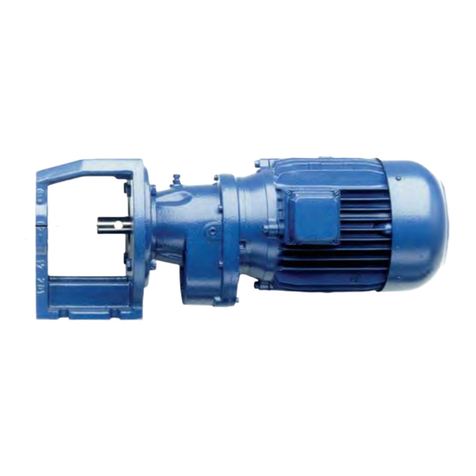
Seepex
Seepex BN 5-12 Series Manual
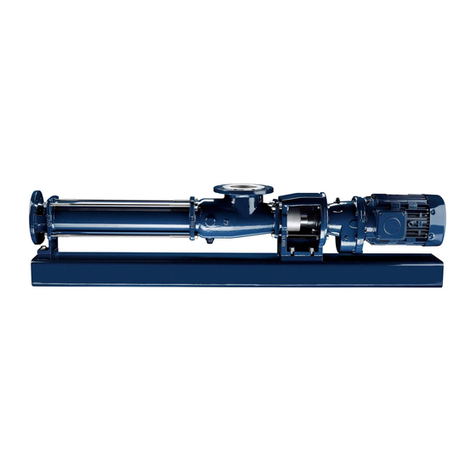
Seepex
Seepex BN 2-12S Product guide
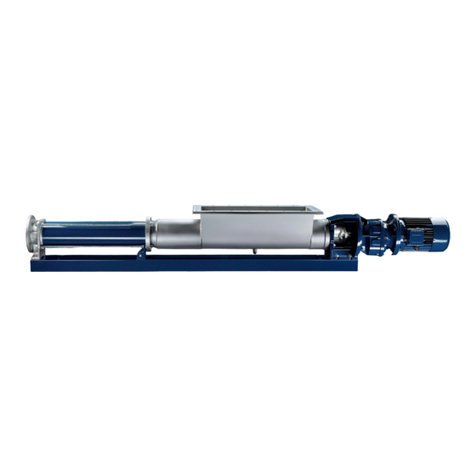
Seepex
Seepex BTQ Series Product guide

Seepex
Seepex BCSO 025-24 to 130-6L Product guide

Seepex
Seepex Macerator 110 Series Product guide

Seepex
Seepex BTVE 10-12 Product guide
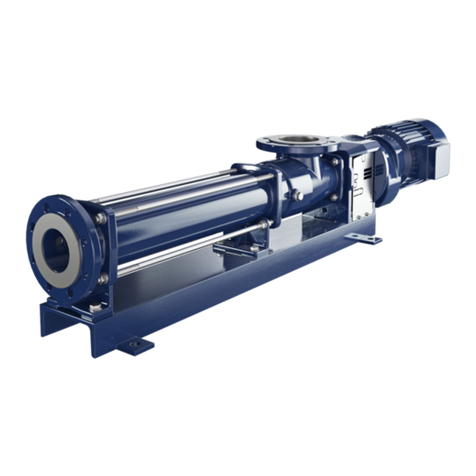
Seepex
Seepex BN 52-6LS Product guide

Seepex
Seepex BN 2-12S Product guide
Popular Water Pump manuals by other brands
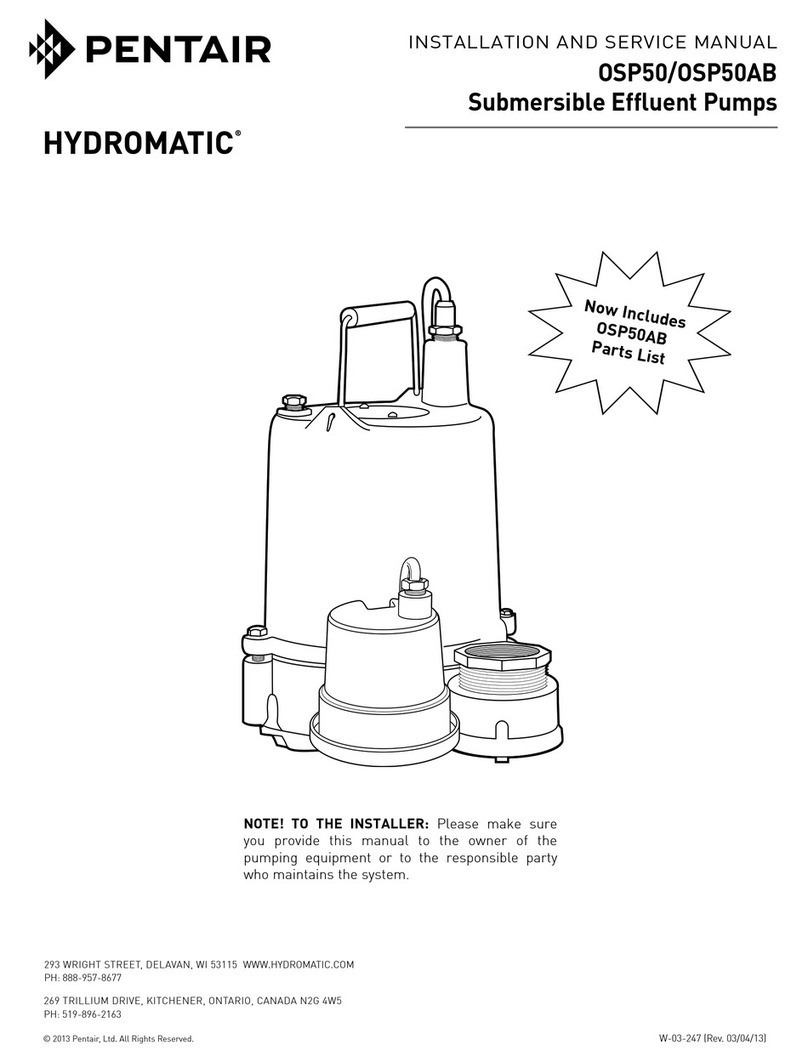
Pentair
Pentair HYDROMATIC OSP50 Installation and service manual
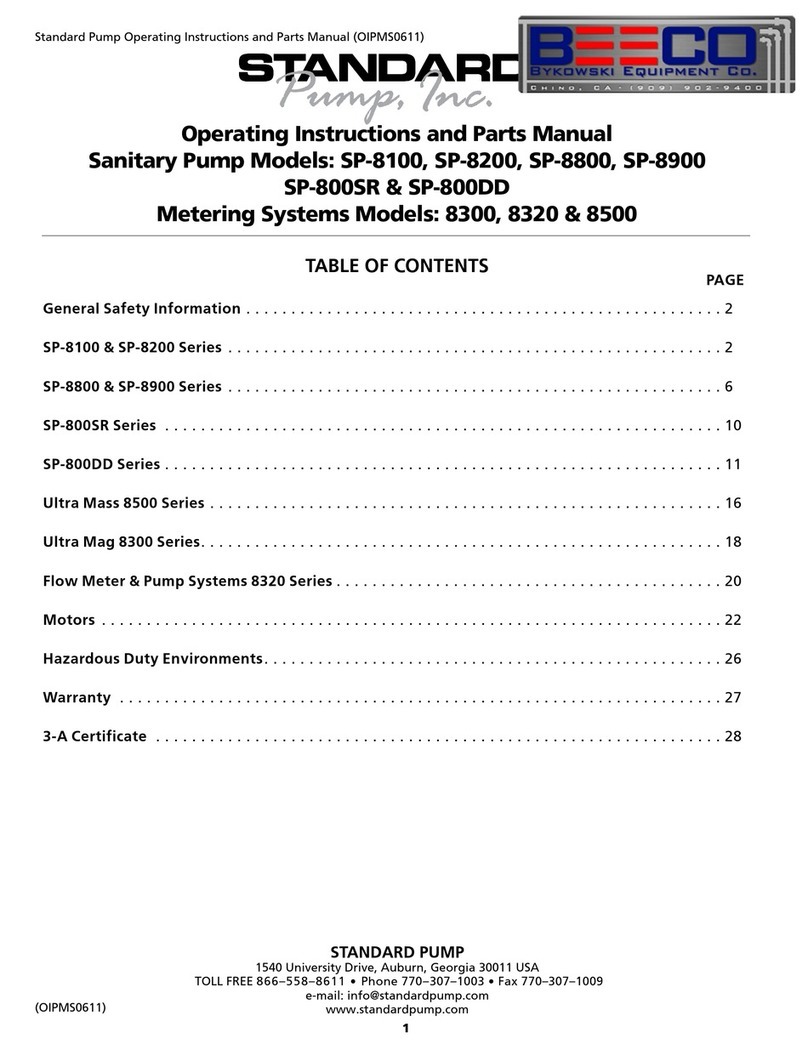
Standard Pump
Standard Pump SP-800DD Operating instructions and parts manual

BUSCH
BUSCH Dolphin LX 0030 A Installation and operating instructions

Utilitech
Utilitech 50AC-110 Install manual
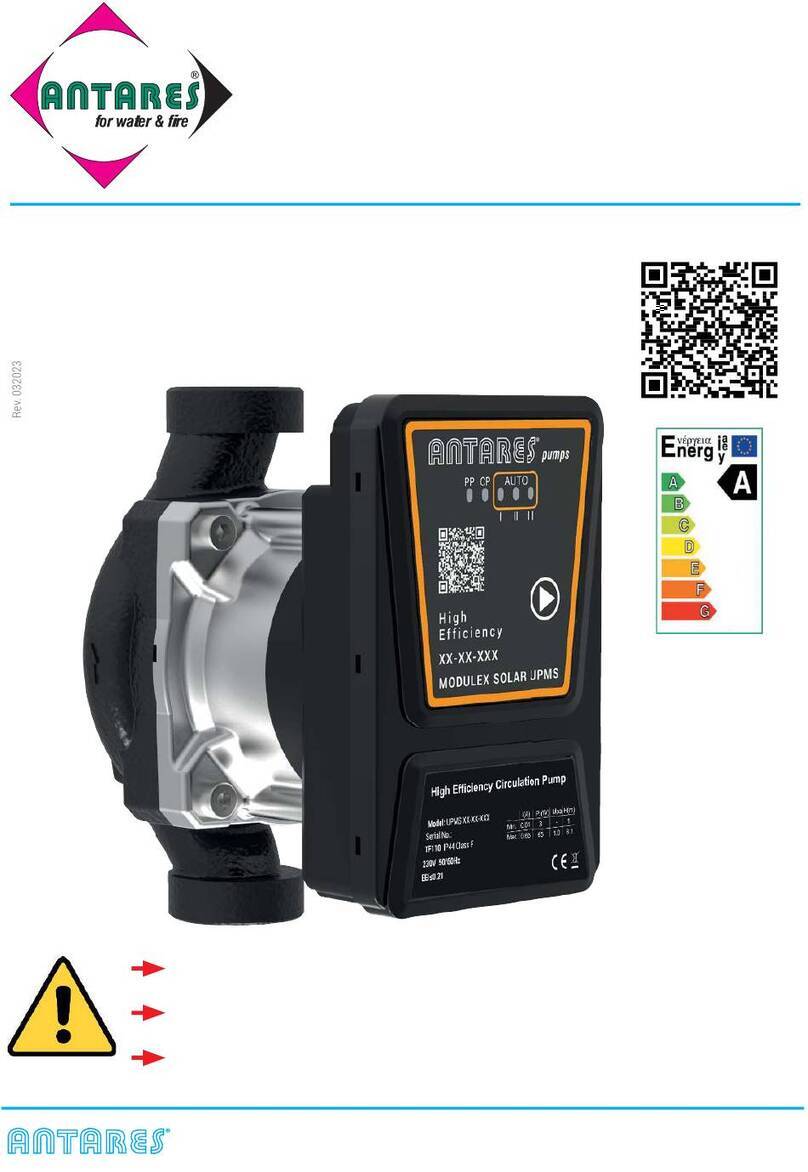
Antares
Antares P.023 Installation and instruction manual

Nash
Nash Boat Life user guide


